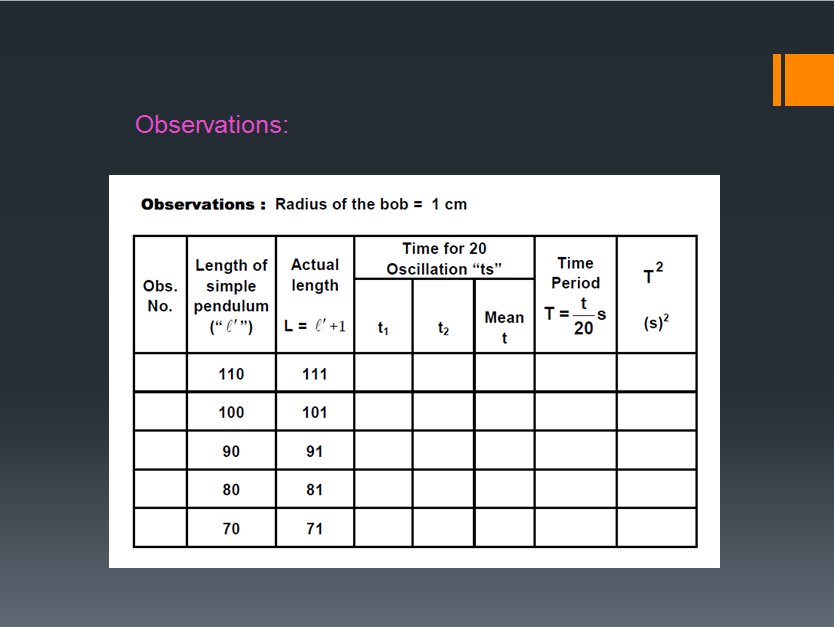
Instead of the acceleration being 9.81 m/s^2 as I hypothesized, it was actually 6.73 m/s^2 when calculated due to calculation and experimental errors. My hypothesis was only partially correct. I concluded that the velocity-time graph did go in a straight line. A random error that occurred was that one group member released the object, not in synchronization with the ticker timer which may have hindered the process of dots being recorded on the tape.
#Measuring acceleration due to gravity lab report free#
The anticipated error was that the numbers would have been rounded and not completely accurate.Īnother systematic error is that the ruler is not 100% accurate when measuring it may be off by. In this study, a simple Arduino-based experiment was designed to examine the acceleration of the object during free fall and to calculate the value of g. One error might be in the calculations in Table 1. ErrorsĪfter performing the experiment, several errors were noted.


We know that velocity changes with t = time and displacement changes with v = velocity. Given the formula vf = vi +at and d = (vf +vi/2). (2) Purpose (Section 2 on the handout: Lab Reports). Due to a change in velocity, there was a change in displacement. By varying the angle of the incline and measuring the acceleration, the acceleration due to gravity. This was because as time increases, velocity changed at a constant rate. The change in velocity of an object in free fall was directly proportional to the displacement. The velocity position graph (refer to graph 2) was curved because changing velocity means change in slope.ĥ. The slope of the velocity time graph was accelerating 6.74 m/s^2. You will be measuring the acceleration of an object attached to a pulley system known as an Atwood machine (see prelab Fig. The relationship between the change in velocity and elapsed time was that the velocity increases constantly as the time increases therefore they were proportionate.ģ. Purpose The purpose of this lab is to demonstrate how imperfections in an experimental apparatus can play a large role in the final results. It was heading in a positive direction (refer to graph 1).Ģ. The velocity-time graph is in a straight line, meaning it was going at a constant acceleration. Part 2 In the second part of the lab, we will use the time measured to determine the acceleration due to gravity. (3) We will make the measurement of time of fall for a free falling ball in this part of the experiment. Therefore the acceleration throughout was 6.74 m/s^2 this may be caused by experimental errors and calculation errors.ġ. We can calculate the acceleration by deriving from the kinematic equation for position, which we will use in this lab to approximate our trails and see if we. The experimental measurement can be expressed in the form of Best Estimate Uncertainty as x x avg. = 674 cm/s^2 (*note: To convert into meters, I divided (674 cm/s^2) by 100) Therefore at 0.2s, the average velocity was 92cm/s.Īcceleration was found by finding the slope of the velocity time graph.

The objective of this experiment was to estimate the value of gravitational force (g). To find average velocity I did the following: Measuring the acceleration due to gravity with a Simple Pendulum). One example calculation would be at 0.2 seconds, when displacement is 9.2cm. Start PicoScope to capture the data (using the single trigger event). Position from the start (cm)Īverage velocity was found by dividing change in time by displacement. Measure and note the distance between the two coils. I measured and recorded the position from the start of the tape corresponding to each half time interval and then plotted a velocity-position graph using the velocities I recorded. Through the use of the Core Motion framework, we are able to accesswith great ease a variety of hardware built into our iOS device in order to acquire such unique information, from magnetic fields, to accelerations, both by gravity and otherwise, to rotation rates, about the specific situation of our device.I calculated the slope of the velocity-time graph, which gave me acceleration in cm/s^2. This could be anything from simply detecting the orientation of the device to incorporating rotation into a racing game’s steering system, to using an accelerometer to measure the acceleration of a roller coaster. world, a developer can specifically build applications focused on enhancing the user’s experience based on his or herphysical situation. By retrieving information about the outside. Now, we will deal with an entirely opposite topic: data from the outside world-not in the sense of data given by the user, but instead, data collected by the device about the universe in which it exists at any given second. The last two chapters spent an incredible amount of time on dealing with information stored and persisted inside a device’s memory.


 0 kommentar(er)
0 kommentar(er)
